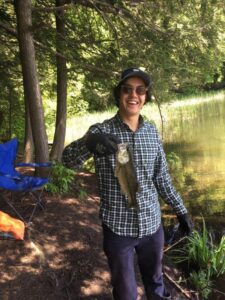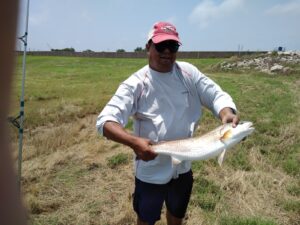This is a guest post by Eric LeeChee, a law student who interned with Bayou City Waterkeeper in the Spring 2021 semester.
As I wrap up my last year of law school at Vermont, I was excited to spend my final semester in the Houston area working with Bayou City Waterkeeper as a Legal Intern. This gave me the chance to learn about the law firsthand — by helping the organization research legal issues relating to local sanitary sewer overflows, investigating wetland losses, delivering comments in support of language access at the Federal Energy Regulatory Commission, and even taking nurdle samples on the coast. It also meant I could spend my free time fishing with my dad and brother.

Fishing the Guillotine with my family
I moved to Katy, Texas at the age of 12 from Calgary, Canada, where freshwater trout fishing was the prime sport. My dad, brother, and I found a new love for fishing as we tried to settle in. We visited the Gulf of Mexico frequently to go sport fishing for redfish, king mackerel, and red snappers. We also fished bayous and lakes scattered across Texas for smallmouth and largemouth bass.
Our favorite spot to fish is in Freeport at a place called “the Guillotine,” for a so-called “guillotine gate” in the Brazos River that protects boats from hurricanes and storm surges. The marine life in the area is really diverse, with dozens of species of fish like redfish, sheepshead, speckled and sand trout, gafftop catfish, drum, perch, flounders, sharks, and various bait fishes, along with dolphins. Oyster beds are scattered all along the shores, attached to rocks and surrounded by crabs. Coves on each side of the guillotine gate offer ideal breeding grounds for smaller fish — and for larger, predator fish to find a meal. Flocks of birds fly above looking for meals from the schooling and jumping fish.

The freeze spares the Guillotine but kills millions of fish statewide
Texas Parks and Wildlife reported that the February freeze killed an estimated 3.8 million fish along the entire Texas coast. Most of the fish that were killed were smaller fish, which may affect growth up the food chain for both larger game fish and birds. Many fish died in shallower waters, where they had no access to deeper areas where they could seek warmth. Galveston Bay and the intercoastal waterways were hit particularly hard due to their shallow depths at an average of 6 feet.
The Guillotine, which has deep water that gave fish a place to retreat, seemed to be spared. Since the February freeze, I have gone back to the Guillotine four times with my family to go fishing. Each time we caught over 75 fish combined — which is typical for the area. (We threw 95% of them back.) I have also seen many families catch their daily limits for sand trout and redfish in a couple of hours at the guillotine. Even after the freeze, it remains a fishing hot spot.
As I wrap up my semester with Bayou City Waterkeeper, I want to urge all Texans, not just those who like to fish, to get out and enjoy Texas’ natural areas and experience the wonders that our region has to offer: jumping fish, diving birds, passing dolphins, and open water. Texas has so many beautiful places, including the Guillotine, that are perfect for a day trip by yourself or with your family.
Eric LeeChee wrapped up his final year of law school at Vermont Law School with a full-time externship at Bayou City Waterkeeper. Originally from Calgary, Alberta, Eric moved to and grew up in Katy, Texas. In 2018, Eric graduated from Saint Edward’s University with a B.S., majoring in Environmental Science and Policy with a minor in Political Science. Before joining Bayou City Waterkeeper, Eric completed an internship for a U.S. District Court. He enjoys fishing, playing soccer, skateboarding, hiking, reading and travelling.
